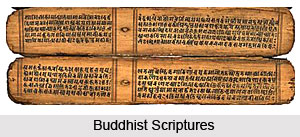 The Theravada School of Buddhism considers Tripitaka (Pali Canon) as the most authoritative text that contains the teachings of Gautama Buddha. The Sutta and Vinaya segments of the Tripitaka text are overlapped and have similarities with the texts used by the non-Theravada schools that exist primarily in Chinese language. Both these kinds of texts are considered as the oldest ones on Buddhist principles. It is widely believed that the Pali text was taken to Sri Lanka during the rule of Emperor Ashoka. Theravada Buddhism is one of the first Buddhist schools that have its entire text in written form.
The Theravada School of Buddhism considers Tripitaka (Pali Canon) as the most authoritative text that contains the teachings of Gautama Buddha. The Sutta and Vinaya segments of the Tripitaka text are overlapped and have similarities with the texts used by the non-Theravada schools that exist primarily in Chinese language. Both these kinds of texts are considered as the oldest ones on Buddhist principles. It is widely believed that the Pali text was taken to Sri Lanka during the rule of Emperor Ashoka. Theravada Buddhism is one of the first Buddhist schools that have its entire text in written form.
The Pali Tipitaka or the Scripture of Theravada is comprised of three parts: the Vinaya Pitaka, Sutta Pitaka and Abhidhamma Pitaka. Amongst these Abhidhamma Pitaka is seen as the later addition. Some of the Buddhist scholars are of the view that the first two Pitakas only existed during the First Buddhist Council. Hence the Pali Abhidhamma Pitaka was not recognized by any other school of Buddhism other than the Theravada School.
There are several commentaries that accompany the Tipitaka text. Of these the first one was written by Buddhaghosa Thera in the 4th or 5th centuries. These commentaries have become a part of the Theravada culture.
Through these scriptures it becomes easier to comprehend the cultural heritage of Theravada Buddhism. The segments of Sutta Pitaka and Vinaya Pitaka were common to early Buddhist tradition. As a result these are not unique to Theravada School of Buddhism.









